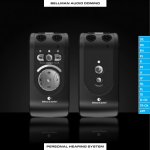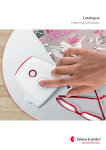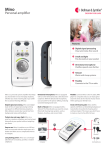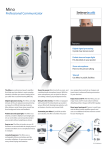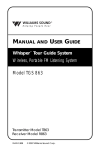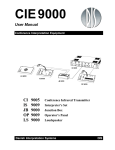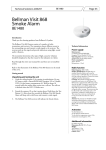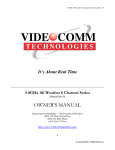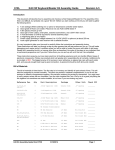Download personal hearing system bellman audio domino classic
Transcript
BELLMAN AUDIO DOMINO CLASSIC PERSONAL HEARING SYSTEM Contents 2Contents 3Introduction 4 Important Safety Instructions 7 What is in the box? 7Figure references 9 Getting started 9Testing 11 How to use Bellman Audio Domino Classic 12 Symbols and indicators 13Charging 14Using the Receiver Unit 14 Switching on the Receiver Unit 14 Selecting the sound volume 15 Selecting the tone 15Using the Transmitter Unit 2 Bellman Audio Domino Classic Personal Hearing System, BE2250/BE2270 15 16 16 Switching on the Transmitter Unit Listening via the Transmitter Unit Listening on the Receiver Unit’s microphone again 17 Switching off 17External sound source 18External microphone 19 Combined signal sources 20 Wireless digital transfer 20 Battery indicator 21Establishing a temporary link with another Transmitter Unit 23Accessories 24Troubleshooting in brief 26Appendix 40Areas of application 48 Warranty conditons Introduction Thank you for choosing products from Bellman & Symfon. Bellman Audio is an assistive listening system. The system consists of a number of units which facilitate listening under different circumstances. Bellman Audio products make everyday life easier for many people and give them the freedom to freely pursue their interests. DE DK EN ES FI FR Bellman Audio Domino comprises easy-to-use wireless audio products which have been specially developed to help in circumstances where listening is difficult. The use of the latest technology in digital signal processing, encryption and wireless technology provides you with fantastic sound quality, secure and reliable radio transmission and great flexibility in how you use the system. The radio solution used and the flexible battery charging ensure that the products can be used safely and easily throughout the world. IT JP NL PL SE SI-CN TR-CN Read through the entire user manual before starting to use the product. Refer to the diagram showing the accessories and connection options. APP 3 Important Safety Instructions • • • • • • • • • • • • • 4 Read these Instructions. Keep these Instructions. Heed all Warnings. Follow all instructions. Do not use this apparatus near water. Clean only with a dry cloth. Do not block any of the ventilation openings. Install in accordance with the manufacturers instructions. Do not install near any heat sources such as radiators, heat registers, stoves, or other apparatus (including amplifiers) that produce heat. Do not defeat the safety purpose of the polarized or grounding - type plug. A polarized plug has two blades with one wider than the other. A grounding type plug has two blades and a third grounding prong. The wide blade or the third prong are provided for your safety. When the provided plug does not fit into your outlet, consult an electrician for replacement of the obsolete outlet. Protect the power cord from being walked on or pinched particularly at plugs, convenience receptacles, and the point where they exit from the apparatus. Only use attachments/accessories specified by the manufacturer. Unplug this apparatus during lightning storms or when unused for long periods of time. Refer all servicing to qualified service personnel. Servicing is required when the apparatus has been damaged in any way, such as power-supply cord or plug is damaged, liquid has been spilled or objects have fallen into the apparatus, the apparatus has been exposed to rain or moisture, does not operate normally, or has been dropped. Please note: The BE2250 and BE2270 Bellman Audio Domino Classic Personal Hearing Systems are not hearing instruments. Bellman & Symfon AB recommend that anyone who is experiencing hearing loss should consult a doctor. Warning! The BE2250 and BE2270 Bellman Audio Domino Classic Personal Hearing Systems have a very powerful amplifier and the sound level can cause discomfort or, in serious cases, endanger hearing if the product is used carelessly. Always turn the volume down to a low level before putting on the headphones! DE DK Warning! The Bellman Audio Domino Classic Personal Hearing System is powered by rechargeable Lithium-Ion batteries. Do not expose the batteries to fire or to direct sunlight. The batteries must only be changed by Bellman & Symfon staff and must only be replaced by batteries of the same type. There is a risk of explosion if the batteries are not replaced correctly. The batteries must be charged fully before using the products for the first time. Batteries should be charged in temperatures of between +5°C and +40°C. EN Warning!The Bellman Audio Domino Classic Personal Hearing System must only be charged by charging accessories recommended by Bellman & Symfon. NL Warning! The AC/DC adapter must not be exposed to water drops or splashes and objects containing liquids, such as vases must not be placed on the unit. To disconnect the power fully, the AC/DC adapter plug must be disconnected from the mains socket. The AC/DC adapter plug must not be blocked and must be easy to access for the intended use. Rating information is shown on the rear of the AC/DC adapter. ES FI FR IT JP PL SE SI-CN TR-CN APP Warning! To reduce the risk of fire or electric shock, do not expose this appliance to rain or moisture. 5 Warning! For the safety of your children - Please be aware that this product may include small parts. Ensure that the package and small parts are kept out of reach of children. This symbol indicates that integral electrical equipment must not be treated as household waste. It should be taken to the relevant collection depot for the recycling of electrical and electronic equipment. You can obtain more detailed information about recycling of the product from your local authorities, from the nearest recycling station or from the shop you purchased the product from. What is in the box? The box contains everything you normally need in order to use Bellman Audio Domino Classic. The box contains: A BE2250 Receiver unit B BE2270 Transmitter unit C BE9147 Travel case DUser manual E BE9142 Universal charger with 4 mains plugs F BE9139 Charging cable, USB G BE9135 Neck strap with safety clasp (2 pcs) H BE9124 In-ear Phones Figure references 1 Receiver unit Internal microphone for Receiver Unit 2 Internal microphone setting LED 3 Battery status LED DE DK EN Green: Switched on with well charged battery Blinking Green: Switched on but the battery charge is low Blinking Orange: Switched on with flat battery - will soon switch itself off Orange: Charging ES FI FR IT JP NL PL SE 4 5 LED for listening via transmitter SI-CN Green: Omnidirectional microphone Orange and Green: Line in (external sound source) Button for selecting internal microphone TR-CN APP 6 7 6On/off button 7 Button for selecting listening via transmitter 8 Volume and Tone LED Indicator 9 Button for increasing sound level 10 Button for reducing sound level 11 Button for reducing treble 12 Button for increasing treble 13 Headphone output 3.5 mm jack plug 14 Charging socket 15Clip 17 Battery status LED Green: Switched on with well charged battery Blinking Orange and Green several times: An external sound source has been connected Blinking Green: Switched on but the battery charge is low Blinking Orange: Switched on with flat battery - will soon switch itself off Orange: Charging 18On/off button 19 Button for pairing up Transmitter Unit with Receiver Units 20External sound source input 2.5 mm jack plug 21 Charging socket 22Clip 8 Getting started Transmitter unit 16 Internal microphone for Trans mitter Unit Testing 1 2 3 Both the Transmitter and Receiver Units are supplied with built-in rechargeable batteries. The batteries in both the Transmitter Unit and Receiver Unit must be fully charged before using the products for the first time. Please use the charger supplied. Connect the Headphones to the headphone output (13) and switch on the Receiver Unit by pressing and holding the On/Off button i (6) for ~2 seconds. Listen to the Receiver Unit’s microphone and adjust the volume using the Volume Buttons + or - (9 or 10). Switch on the Transmitter Unit by pressing and holding the On/Off button i (18) for ~2 seconds. Switch over to listen via the Transmitter Unit’s microphone by pressing the external sound button (7). If you connect the Transmitter Unit Sound Input (20) to the headphone output on an external sound source you can, for example, listen to music via the Transmitter. The volume control adjusts the sound level. + (9) raises and - (10) lowers the volume while the Volume and Tone LED Indicator (8) shows the sound level. The more LEDs that are lit the higher the volume. The LED indicator goes out 10 seconds after the sound volume has been set. DE DK EN ES FI FR IT JP NL PL SE SI-CN TR-CN APP The tone control adjusts the sound quality. > (12) increases and < (11) reduces 9 the treble. The Volume and Tone LED Indicator (8) shows the tone setting. The LED indicator goes out 10 seconds after the sound quality has been set. When you have finished, you can switch off the Transmitter and Receiver Units by pressing the On/Off buttons i (6, 18) and holding them down until the Battery Status LEDs (3, 17) go out. How to use Bellman Audio Domino Classic The BE2250 and BE2270 Bellman Audio Domino Classic Personal Hearing Systems are personal hearing systems which have been specifically developed to provide an excellent sound experience even in demanding situations. Bellman Audio Domino Classic works extremely well for speech and music. You can use the built-in microphones in the Receiver Unit and the Transmitter Unit or use an external sound source. You can use an external microphone or the stereo cable set as an external source source for connection to a stereo sound source. DE DK EN ES FI FR IT JP NL PL SE SI-CN TR-CN APP 10 11 Symbols and indicators Charging The following symbols are used in the user manual and can be explained as follows: Both the Transmitter and Receiver Units are supplied with built-in rechargeable batteries. The batteries in both the Transmitter and Receiver Units must be charged before using the products for the first time. The warning triangle indicates information which must be followed in order to guarantee operation and also in some cases to ensure personal safety. The light bulb (tip, note) indicates information which can be useful to help you get the most out of the product. 5s I II V 12 III IV IA permanently lit LED is indicated by solid indi cator. IIA blinking LED is indicated by a sunlike solid indicator. III Indicators that are switched off are indicated by an empty circle. IV If a button must be held down for more than a certain time, this is indicated by a grey button and a stop watch symbol with a figure which corresponds to the number of seconds that the button must be held down for. V Button presses are marked in grey on the specified button. Bellman Audio Domino Classic contains Lithium-Ion batteries and a universal charger with plugs for the EU, United Kingdom, USA and Australia to suit the majority of wall sockets used around the world. Warning: The product may only be charged with the charger supplied or using accessories from Bellman & Symfon. Connect the charger as illustrated in the fold-out section of the manual. DE DK EN ES FI FR IT JP Select the mains plug for the appropriate region and check that it is locked properly before it is connected to the wall socket. When the charging connectors are connected to the charger, the Transmitter Unit and the Receiver Unit, the Battery Status LEDs (3 and 17) change from green to orange to indicate that charging is taking place. When charging is finished, after about 2.5 hours, the LEDs turn green again. You can charge one unit at a time or two at the same time. NL PL SE SI-CN TR-CN APP 13 Using the Receiver Unit Connect BE9122 Bellman Stereo Headphones, BE9159 Bellman Neck Loop, BE9125 Bellman Stetoclip, BE9124 Bellman In-ear Phones or another listening product recommended by Bellman & Symfon to the headphone output (13) on the right-hand side as illustrated in the fold-out section of the manual. Switching on the Receiver Unit Press the On/Off button i (6). The Battery Status LED (3) starts to shine with a green light to indicate that the unit is on. Selecting the tone Use the tone control’s < button (11) to reduce and the > button (12) to increase the treble in the tone. The Volume and Tone LED Indicator (8) shows the selected setting. The LED indicator goes out 10 seconds after the sound quality has been set. DE DK EN ES The Receiver Unit can be used as a small and adaptable self-contained call amplifier, but together with the Transmitter Unit it opens up a whole new range of possibilities. You can achieve the greatest flexibility when using the Receiver Unit together with the Transmitter Unit. FI FR IT JP NL Selecting the sound volume Use the volume control’s + button (9) to increase and the - button (10) to decrease the sound level. The Volume and Tone LED Indicator (8) shows the sound level. The more LEDs that are lit the higher the volume. The LED indicator goes out 10 seconds after the sound volume has been set. 14 PL Using the Transmitter Unit SE Switching on the Transmitter Unit Press the On/Off button i (18). The Battery Status LED (17) starts to shine with a green light to indicate that the unit is on. TR-CN SI-CN APP 15 Listening via the Trans mitter Unit To listen on the microphone in the Transmitter Unit press the R button (7) on the Receiver Unit. The external sound LED (4) comes on and the sound detected in the Transmitter Unit is now heard in the headphones. Listening on the Receiver Unit’s microphone again If you want to switch back to the internal microphone, give a short press on the M button (5). The internal microphone LED (2) comes on and the sound heard in the headphones now comes from the Internal Microphone (1) again. OFF 1s OFF 1s Switching off When you have finished, you can switch off the Transmitter and Receiver Units by pressing the On/Off buttons i (6, 18) and holding them down until the Battery Status LEDs (3, 17) go out. External sound source If the audio cable (which has a small 2.5 mm jack plug on one end), or if the External Microphone is connected to the Transmitter Unit’s external sound source input (20), the Transmitter Unit’s internal microphone will be disconnected and the external sound source will be automatically selected. The Battery Status LED blinks orange several times to confirm that an external sound source has been connected. The External Sound LED (4) will light up green and orange at the same time to indicate that the sound is coming from an external sound source. If the audio cable is disconnected, the sound will be reconnected to the Transmitter Unit’s microphone again. DE DK EN ES FI FR IT JP NL PL SE SI-CN TR-CN APP With the audio cable connected between a Transmitter Unit and a TV, hi-fi equipment, MP3 player or similar sound source you can listen to absolutely first class stereo sound without being limited by cables. The input sensitivity is automatically adjusted to suit different sound sources. 16 17 External microphone You can connect an external microphone to the Transmitter’s 2.5 mm socket (20). The Battery Status LED blinks orange several times to confirm that an external sound source has been connected. The External Sound LED (4) will light up green and orange at the same time to indicate that the sound is coming from an external sound source. In some cases it may, for example, be easier for a lecturer to have an external microphone and a Transmitter Unit in his/her pocket than to speak in a loud voice or carry a wired microphone. A Transmitter Unit can transmit speech to one or more Receiver Units at the same time. 2s Combined signal sources When you are listening via the Transmitter Unit’s microphone or an External Sound Source, this sound can be combined with the sound that the internal microphone in the Receiver Unit is receiving. Choose to listen on the Transmitter Unit by pressing the R button (7). Hold down the M button (5) until both the MIC (2) and RF LEDs (4) light up. DE DK EN ES FI FR IT JP The input sensitivity is automatically adjusted to a suitable amplification when an external microphone is connected. Please note that the Transmitter Unit’s Battery Status LED (17) blinks alternately green and orange several times when an external sound source is connected. 18 The sound from the Transmitter Unit is mixed with the sound from the internal microphone. You can adjust the balance between the Receiver Unit and the Transmitter Unit’s microphone by holding down the M button (5) at the same time as setting the balance using the < (11) or > buttons (12). NL PL SE SI-CN TR-CN APP 19 Establishing a temporary link with another Transmitter Unit If you want to go back to listening on the Transmitter Unit, press the R button (7) and if you want to switch over to listening on the internal microphone, press the M button (5) instead. The radio link between the Transmitter and Receiver Units in the Bellman Audio Domino Classic must be established in order for radio communication to operate. To make it easy to get started, Receiver Units and Transmitter Units which are supplied together are always paired up so that they will work together. Wireless digital transfer Bellman Audio Domino Classic uses the latest radio communications technology to digitally transfer sound with an exceptionally high sound quality in stereo. The radio transmission is encrypted to ensure the highest level of security and confidentiality. Radio communication takes place on 2.4 GHz which is a frequency range whose use is permitted throughout the world. Battery indicator The Battery Status LED (3, 17) normally lights up green. This indicates that the unit is switched on and the battery level is satisfactory. When the battery is low, the Battery Status LED (3, 17) blinks green until the battery is almost completely flat when it blinks orange instead. As soon as it blinks green it is time to charge the unit again. If the unit is not charged, it is switched off automatically. Charging starts automatically when you connect a charger to the Charging Socket (14, 21). Charging in progress is indicated on both the charger and the units by an orange light. Once the battery is fully charged, the indicator changes to green and the battery is continuously trickle charged until the charger is disconnected. 20 DE • • • Whenever you want to listen on another Transmitter Unit you can establish a temporary link with it. As soon as you switch off the Receiver Unit it returns to working with the paired Transmitter Unit again. Proceed as follows to establish a temporary radio link between a transmitter and a receiver: DK Start both the units with the On/Off buttons (6, 18). Hold down CONNECT (19) on the Transmitter Unit. Hold down both the M button (5) and the R button (7) on the Receiver Unit. FR 5s 5s A ”running light” on the Receiver Unit’s Volume and Tone LED Indicator (8) moving towards the centre indicates that the link has been established. EN ES FI IT JP NL PL SE SI-CN TR-CN APP 21 Accessories The link can only be established while the Transmitter Unit’s connection button is pressed down - this is for safety reasons to prevent a Receiver from being able to connect to another Transmitter unobserved. Please note that it is possible to connect several Receiver Units to the same Transmitter Unit by repeating the above procedure. There is, however, a risk that the number of receivers may affect the performance of the system. The following accessories are available: • • • • • • • • • BE9122 Stereo headphones BE9124 In-ear phones BE9125 Stetoclips BE9137 Stereo cable, 1.5 m with adapter from 3.5 mm jack to RCA (phono) connectors BE9126 Stereo Cable Kit, 5 m (16 feet) BE9136 Microphone with clip BE9159 Neck loop BE9141 Deluxe Travel case BE2250 Receiver unit For all accessories and for more information about the latest accessories please visit our website at http://www.bellman.com. DE DK EN ES FI FR IT JP NL PL SE SI-CN TR-CN APP 22 23 Troubleshooting in brief Problem Solution Connect the radio link and check that the connection is made without problems. Problem Solution Check that the sound source is correctly connected to the Transmitter if the stereo cable is connected to the External Sound Source Input (20). Nothing happens when you Connect the charger and check that charging starts within try to start the units. 10 seconds. No sound can be heard in the headphones when the Receiver Unit is switched on. Please note! If charging does not start within 10 seconds, disconnect the charger immediately and contact the nearest dealer! A high-pitched noise is heard in the headphones. Turn up the volume using the volume control (9). The sound breaks up or comes and goes. Check that the internal microphone has been selected as the signal source and that it works by gently scraping on the microphones (1). Check that the headphone plug is securely inserted in the headphone output. Connect the headphones to another sound source (with a 3.5 mm headphone output) to test whether the headphones are working. No sound can be heard in the headphones when the Receiver Unit is switched on and External Sound is selected. 24 Check that the Transmitter Unit is switched on. Check that the external microphone has been selected as the signal source and that it works by gently scraping on the microphone (16). Turn down the volume or increase the distance between the microphone and headphones. Direct the microphone away from you. DE DK EN ES FI The Receiver Unit is too far away from the Transmitter Unit. Move the units closer together. FR More than one Receiver is connected to the Transmitter and at least one Receiver is too far away from the Transmitter. JP IT NL Too many Receivers are connected to the same Trans mitter. PL There are too many transmitters on 2.4 GHz or too many Domino systems nearby which affect one another. SI-CN Please note that walls, concrete panels and metal reduce the range. APP SE TR-CN Check that the Transmitter is within range. 25 Appendix Settings Version information The product version information is presented here via a pattern of lit and blinking LEDs. This internal information is only intended as an aid for servicing and support. Bellman Audio Domino Classic has some settings that you cannot access in user mode. Go into the Settings Menu to change settings that you do not normally need to change. DE DK APP Pairing of units The Transmitter and Receiver Units in the Bellman Audio Domino system must have the radio link established in order for radio communication to operate. To make it easier to get started, a Receiver Unit and a Transmitter Unit which are paired together are always supplied so that they will work together. Where you want to pair a Receiver Unit with a Transmitter Unit which is different from the Receiver Unit it was originally supplied with, you can do this in the Settings Menu. Settings Menu Start the Receiver Unit with the On/Off button i (6). ES FI FR IT JP NL PL SE SI-CN TR-CN APP Hold down the On/Off button i (6) and press the Volume Button -(10) within 1 second for at least 3 seconds. You are now in Version Information mode. 26 27 Testing Proceed as follows to pair up the units: 5s 5s • Start both the units with the On/Off buttons i (6, 18). • Go into the Settings Menu. • Hold down the CONNECT button (19) on the Transmitter Unit. • Hold down both the M button (5) and the R button (7) on the Receiver Unit. • • • • 28 DE How to test APP The testing of Bellman Audio Domino Classic has been divided into three parts. One part for the Receiver Unit for which only the Receiver Unit is required, one part for the Transmitter Unit for which both units are required and finally one for charging the two units. A ”running light” on the Receiver Unit’s Volume and Tone LED Indicator (8) moving towards the centre indicates that the link has been established. Please note! If you pair up a Transmitter Unit and a Receiver Unit in the Settings Menu, this replaces the pairing carried out in the factory. This can be useful when changing a Transmitter Unit under guarantee or if you want to pair up several Receiver Units to a Transmitter Unit (e.g. in a conference room). It is easy to test the Bellman Audio Domino Classic Personal Hearing System. If the Bellman Audio Domino Classic does not operate as described below, you can carry out further troubleshooting as instructed under Troubleshooting. Receiver Unit Switch on the unit and make sure that the Battery Status LED (3) lights up green. Connect the headphones to the Headphone Socket (13) and scrape carefully on the round microphone (1) with your finger and check that there is a scraping sound in the headphones. Press the buttons (9, 10, 11, 12) and check that the Volume and Tone Indicator changes. DK ES FI FR IT JP NL PL SE SI-CN TR-CN APP Transmitter Unit Switch on the unit and make sure that the Battery Status LED (17) lights up green. 29 • • • Press the R button (7) and make sure that the External Sound LED (4) lights up green. Carefully scrape on the round microphone (16) on the Transmitter Unit with your finger and check that there is a scraping sound in the headphones. Connect an external sound source to the External Sound Source Input (20) and check that the sound from the sound source is heard in the headphones. The External Sound Source Input (20) can be tested, for example, by connecting a CD player or a radio to the input via an audio cable (accessory). The Transmitter Unit automatically switches to an external sound source when a connector is connected to the External Sound Source Input (20). Troubleshooting Problem Solution The Receiver Unit loses its link to the Transmitter Unit when you switch off the Receiver Unit. Pair up the Receiver Unit and Transmitter unit permanently in the Settings Menu. Humming occurs when connecting the stereo cable during charging. Only use the charger supplied, BE9142. DE DK APP ES FI • • • • Charging Connect the charger to the mains socket and check that the LED on the charger light up green. Connect the charging cables to both the charger and to the charging sockets on the Receiver Unit and the Transmitter Unit (14, 21), see the fold-out section of the manual. Check that the LED on the charger change from green to red. Check that the Battery Status LEDs on both the Transmitter Unit and Receiver Unit light up orange. FR IT JP NL PL SE SI-CN TR-CN APP 30 31 Technical information Power supply Battery power Internal Lithium-Ion type, 617 mAh, type NTA2617 CAUTION: Danger of explosion if battery is incorrectly replaced. Replace only with the same or equivalent type. Operating time, fully charged 8-12 hours (standard battery) Transmitter charging time 2.5 hours (standard battery) Receiver charging time 2.5 hours (standard battery) Input signals Microphone Internal electret condenser type (omnidirectional) External sound source input 2.5 mm stereo jack plug (0 dBV max input signal) Automatically selects Aux. input or External mic. Dynamic range 95 dB SNR (electrical) Frequency range 40 – 10.000 Hz (electrical) Max output level, saturation BE9122 Headphones BE9124 Ear Phones BE9125 Stetoclips BE2250: 124.3 dB SPL / BE2270: 124.3 dB SPL (@ 2.5 kHz) BE2250: 132.0 dB SPL / BE2270: 130.5 dB SPL (@ 5 kHz) BE2250: 133.7 dB SPL / BE2270: 133.6 dB SPL (@ 1 kHz) Full on gain BE9122 Headphones BE9124 Ear Phones BE9125 Stetoclips (60 dB SPL input signal @ 1 kHz): BE2250: 42.5 dB / BE2270: 44.0 dB BE2250: 55.0 dB / BE2270: 57.5 dB BE2250: 58.2 dB / BE2270: 64.2 dB Full on gain BE9122 Headphones BE9124 Ear Phones BE9125 Stetoclips (60 dB SPL input signal, HFA): BE2250: 46.5 dB / BE2270: 49.0 dB BE2250: 51.5 dB / BE2270: 56.0 dB BE2250: 52.0 dB / BE2270: 59.4 dB Output signals 32 DK APP ES FI FR IT JP NL Radio function Digital radio technology DE 2.4 GHz frequency band, 3 channels Co-exists with other equipment Automatic channel selection 128 bits encryption Headphone socket 3.5 mm stereo jack plug Topology Point-to-point or Point-to-multipoint Output power 100 mW @ 16 Ω load Diversity Distortion BE9122 Headphones 0.6 % THD BE9124 Ear Phones 0.08 % THD 2 antennas for reception, one antenna for transmission (Rx + Rx/Tx) Transmitting output power Max. 25 mW PL SE SI-CN TR-CN APP 33 Radio function Operating range radio Up to 25 meters indoors clear line of sight, up to 100 meters outdoors clear line of sight. Walls, concrete and metal reduce the range. The following may also affect the performance More than one Receiver is connected to a Transmitter and at least one of the Receivers is too far away from the Transmitter. Too many Receivers are connected to the same Transmitter. Too many transmitters on 2.4 GHz or too many Domino systems close to one another. 34 10 channels Dynamic gain range 0-35 dB Compression 3:1 Expansion 1:1,5 Attack time 20 ms <3kHz, 25 ms ≥3kHz Release time 110 ms <3kHz, 200 ms ≥3kHz Dynamic noise reduction 10-channel adaptive noise reduction Feedback cancellation Adaptive phase shift type Digital signal processing 22.050 kHz sampling frequency, 16-bit resolution in stereo 9 steps (5 dB/step) Tone control +/- 10 dB in 9 steps, cut-off frequency 1.6 kHz Power switch On/Off toggle button Microphone and RF-mode Separate mode select buttons R/L-channel balance setting 0-20 dB programmable attenuation (in steps of 5 dB) DE DK APP ES FI FR Additional information Features Volume control Dynamic compressor IT For indoor use only. JP Dimensions HxWxD 99 x 48 x 22 mm NL Weight BE2250: 74 g, BE2270: 70 g PL Colour White/grey with silver-coloured buttons. SE Regulatory requirements CE, RoHS, WEEE, FCC, C-tick SI-CN TR-CN APP 35 Measurements Frequency response Acoustical (BE9122 Headphones, BE9124 Ear Phones and BE9125 Stetoclips). See diagrams below. Output signal with BE9124, In-ear phones DE DK APP ES FI FR IT JP Output signal with BE9122, Stereo headphones Output signal with BE9125, Stetoclips NL PL SE SI-CN TR-CN APP 36 37 FCC compliance statement ear phones headphones STETOCLIPS This device complies with Part 15 of the FCC Rules. Operation is subject to the following two conditions: (1) this device may not cause harmful interference, and (2) this device must accept any interference received, including interference that may cause undesired operation. DE Warning: Changes or modifications to this unit not expressly approved by the party responsible for compliance could void the user’s authority to operate the equipment. Note: This equipment has been tested and found to comply with the limits for a Class B digital device, pursuant to Part 15 of the FCC Rules. These limits are designed to provide reasonable protection against harmful interference in a residential installation. This equipment generates, uses and can radiate radio frequency energy and, if not installed and used in accordance with the instructions, may cause harmful interference to radio communications. However, there is no guarantee that interference will not occur in a particular installation. If this equipment does cause harmful interference to radio or television reception, which can be determined by turning the equipment off and on, the user is encouraged to try to correct the interference by one or more of the following measures: • Reorient or relocate the receiving antenna. • Increase the separation between the equipment and receiver. • Connect the equipment into an outlet on a circuit different from that to which the receiver is connected. • Consult the dealer or an experienced radio/TV technician for help. Statement for Industry Canada Le fonctionnement de cet équipement est soumis aux conditions suivantes: (1) l’équipement concerné ne doit pas causer d’interférences, et (2) il doit accepter toute interférence reçue, y compris les interférences risquant d’engendrer un fonctionnement indésirable. 38 DK APP Neck loop microphone CABLE KIT, 16 FEET ES FI FR IT JP NL PL SE These original accessories are especially developed to maximize the performance of your Domino. Contact your nearest dealer or visit: www.bellman.com SI-CN TR-CN APP 39 Areas of application 40 At work 41 At school 42 In town 43 When travelling 44 At dinner 45 With a hearing aid 46 In front of the TV 47 Warranty conditons Dear customer. Thank you for your purchase of this Bellman & Symfon® product. Our vision is to supply outstanding products that are of great value for our customers. For this reason, we have put all our best efforts into designing and manufacturing this product. However, if you should have any questions about the product or if you require repair, please contact us. General warranty conditions. Your Bellman & Symfon® product is covered by a limited warranty. Please read the following conditions carefully and keep this information in a safe place. Please also save your receipt or other proof of purchase as you will need this for warranty claims. Warranty period. The warranty is depending on the type of product purchased and is valid from date of purchase. Bellman & Symfon offers warranty as per below: Bellman Products in general Two years of warranty from date of purchase Bellman Neckloop One year of warranty from date of purchase Rechargeable batteries One year of warranty from date of purchase Bellman Accessories 90 days of warranty from date of purchase Warranty conditions. Bellman & Symfon warrants that the Product that you have purchased is free from manufacturing defects in materials and workmanship when dispatched from our warehouse. Your sales receipt is your proof of the date of purchase and the warranty period commences as of that date. During the warranty period, Bellman & Symfon will have the option for the defective product to be repaired or replaced. The replacement product will be of equal or greater function and in good working and physical order. Such a replacement will be supplied from refurbished stock. The repaired or replaced product will be under warranty for the remainder of the original product’s warranty period. Warranty limitations. This warranty automatically becomes void if the product has been physically damaged or rendered defective (a) as a result of accident, misuse, or abuse, or other circumstances beyond Bellman & Symfon’s control; (b) by the use of parts or peripherals not authorized by Bellman & Symfon; (c) as a result of normal wear and tear; (d) by use within an improper operating environment; (e) by modification of the product; (f ) by the serial number or product code sticker being removed or defaced; (g) as a result of service rendered by anyone other than a Bellman & Symfon Authorized Service Agent; (h) as a result of the product being operated other than in accordance with Bellman & Symfon AB’s users manual. Neither does the warranty cover failure due to causes outside Bellman & Symfon’s control such as failure in your phone carrier’s line service (if applicable) or Acts of God. No warranty is offered for disposable batteries. Return policies / warranty claim. Please see www.bellman.com/warranty 48



























